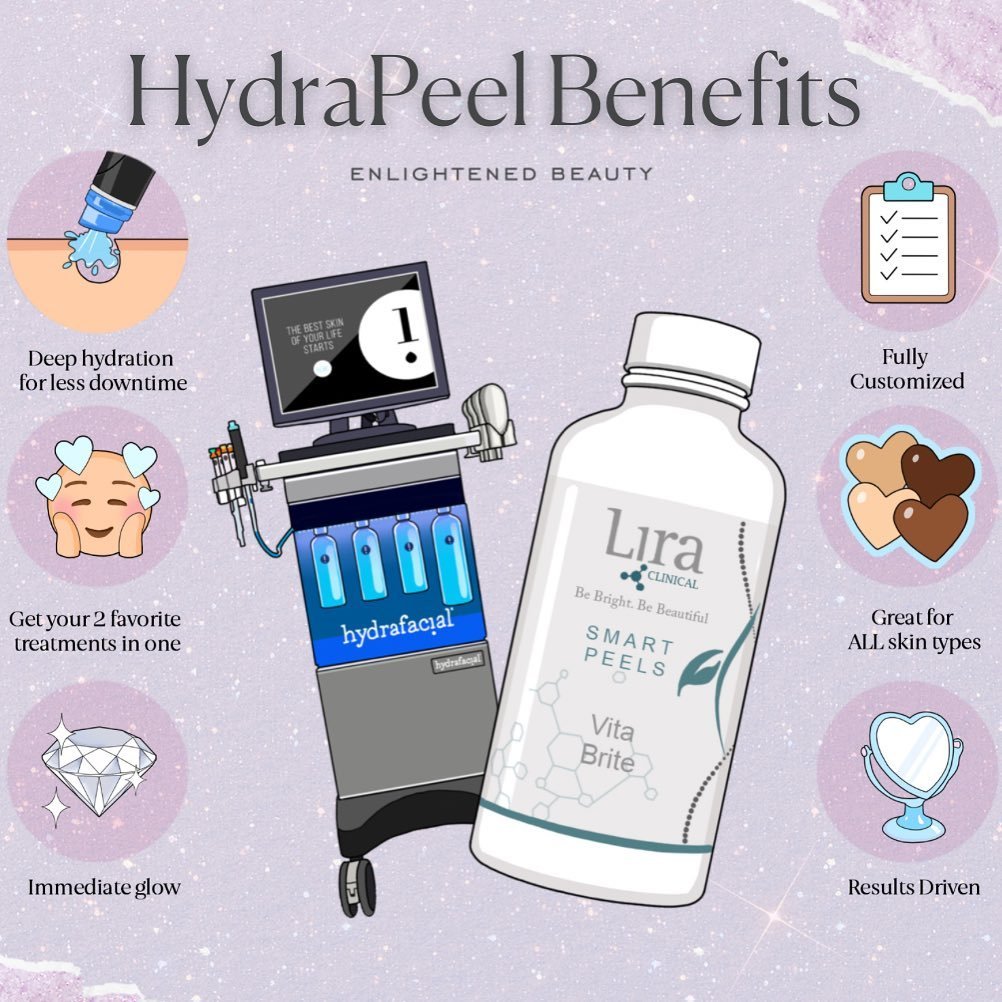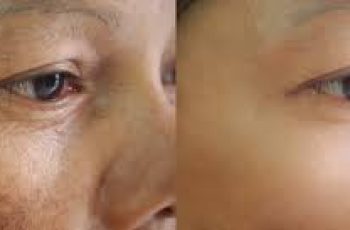In the ever-evolving world of skincare, staying updated with the latest treatments and techniques can feel like a full-time job. Per usual, we’ve got you covered and are here to educate and keep you up to date on it all! Enter the Hydra Peel, a buzzworthy treatment that’s been making waves in the beauty community. But what exactly is a Hydra Peel, and why is it becoming a go-to for skincare enthusiasts and professionals alike?
In this post, we’ll dive deep into the world of Hydra Peel, shedding light on its benefits, the science behind it, and why it might just be the skin-refreshing solution you’ve been searching for.
Whether you’re a seasoned skincare aficionado or just beginning your journey, let’s uncover the magic of the Hydra Peel together.
What Exactly is a Hydra Peel?
The Hydra Peel is a powerhouse skincare treatment that synergistically combines two of our most sought-after procedures — the Hydrafacial + peel.
At its core, it offers a comprehensive approach to skin rejuvenation: exfoliating dead skin cells, reducing the appearance of fine lines and wrinkles, enhancing radiance, and targeting dark spots. The treatment also addresses complex skin concerns like rosacea and ensures a clearer complexion in the days that follow.
What sets the Hydra Peel apart is its infusion of super serums, rich in antioxidants, peptides, and hyaluronic acid. These potent ingredients not only deeply cleanse and extract impurities but also provide intense hydration, fortifying the skin’s natural barrier and promoting a youthful glow.
Who Would Benefit from a Hydra Peel?
Dry skin sufferers, take note: the Hydra Peel is a game-changer. This treatment uniquely combines hydration with chemical exfoliation, targeting skin dryness at its root. While hydration replenishes the skin’s moisture barrier, chemical exfoliants, like alpha hydroxy acids (AHAs), work to remove dead skin cells, promoting cell turnover. The result? A revitalized complexion with reduced inflammation, backed by the proven efficacy of AHAs in enhancing skin hydration and texture.
The Benefits of a Hydra Peel
The Hydra Peel is more than just a treatment, it’s a transformative experience for your skin. Here are some of it’s best benefits:
Deep Hydration with Minimal Downtime: The Hydra Peel provides intense moisture to the skin, ensuring a quicker recovery and less post-treatment redness.
Immediate Radiant Glow: Walk out of your treatment with a noticeable luminosity, giving your skin a fresh and revitalized appearance.
Fully Customized Approach: The Hydra Peel is tailored to address your skin’s unique needs, ensuring optimal results every time.
Suitable for All Skin Types: Whether you have oily, dry, combination, rosacea, pigmented, sensitive skin, you name it, the Hydra Peel adjusts to offer the best care.
Results-Driven: Beyond the immediate benefits, the Hydra Peel focuses on long-term skin health and rejuvenation, ensuring lasting results.
At Enlightened Beauty, we’re all about real results and keeping things straightforward. If you’ve been thinking about trying something new for your skin, give the Hydra Peel a try. And if you’re new around here or just unsure about what’s best for your skin, let’s chat. Book a consultation, and we’ll figure it out together. After all, glowing skin is always in, and we’re here to help you achieve it!
DQH Knowledge drop: In your 20s, your skin cell turnover decreases. (Cell turnover is a key component in keeping your skin youthful.) You know what else slows down? Your collagen production. Starting in your 20s, collagen decreases by about 1 percent per year. Should you want to prevent fine lines and wrinkles, start by eliminating behaviors that contribute to premature aging. “If it’s bad for you, it’s bad for your skin,” says dermatologist Michel Somenek.
“Cigarette smoking reduces blood flow to the skin and causes premature wrinkling and a dull skin texture. Making the repeated pursed motion to inhale can also cause smoker’s lines. Alcohol and recreational drugs are toxins for the skin that damage its cellular structure and DNA,” Somenek tells us. “The faster you eliminate vices while you are young, the better chance your skin and body have to recuperate.” Also, adopting an anti-aging routine in your 20s is key. After all, the best offense is a good defense. We spoke to Somenek and experts Joshua Ross and Audrey Kunin to find out more.
Keep reading for the best anti-aging products for your 20s, according to skincare professionals.
Sunscreen
“We all know that the sun is the number one cause of skin aging and starting the prevention in your 20s is very important,” Ross says. “The majority of your sun damage won’t start to appear until you’re in your 30s, so don’t wait until you see it surface or you’ll be behind the curve. Stay ahead of it with a good-quality zinc-based sunscreen worn daily.”
Farmacy Green Defense Daily Mineral Sunscreen
An invisible sunscreen with SPF 30, plus botanical extracts meant to protect skin with tons of antioxidants. Bonus: It’s clean and fine to use under makeup.
Bareminerals Complexion Rescue™ Tinted Moisturizer Broad Spectrum SPF 30
Although we recommend you use your SPF and moisturizer separately, we also understand moments when you don’t have time or energy for that extra step. For those times, this bareMinerals moisturizer is a great thing to have on hand.
Vitamin C Serum
“A great introduction to anti-aging is to start with a vitamin C serum in your morning skincare routine,” Ross says. “It’s a powerful antioxidant that will neutralize free radicals and brighten the skin.” He adds that it’s a great way to counteract the effects of the sun’s harmful rays, which, as previously mentioned, are among the biggest causes of premature aging.
Drunk Elephant C-Firma™ Vitamin C Day Serum
The Drunk Elephant C-Firma is a lightweight serum that promises to give skin a glow by combining the brightening powers of vitamin C with ferulic acid, l-ascorbic acid, and vitamin E. The included sodium hyaluronate is meant to replace hydration loss, so you shouldn’t have to deal with any irritation.
Sunday Riley C.E.O. Rapid Flash Brightening Serum
This potent serum is jam-packed with vitamin C (15 percent, to be exact), which means it’s a potential superstar at both brightening skin and dousing it in antioxidants.
Peptides
Using peptides on your skin has many benefits, says Somenek. “The skin barrier is what defends the body against pollution, UV rays, bacteria, and toxins. It can be damaged by several everyday factors. Using topical peptides aids in building a stronger barrier,” he says. “Peptides comprise elastic fibers, which are a type of protein. These fibers help to make skin appear taut and firm. Peptides can also help repair damaged skin, relieve inflammation, and even out skin tone. Some peptides can kill acne-causing bacteria that is common in 20-somethings.”
Kunin agrees, saying, “Peptides are an excellent entry point for supporting collagen.” She recommends looking for face and eye treatments that contain these collagen-boosting powerhouses.
Charlotte Tilbury Magic Eye Rescue Cream
This Charlotte Tilbury super-emollient eye cream has a base of coconut oil and shea butter (read: it’s incredibly hydrating). Botanicals plus peptides are meant to help reduce dark circles and boost collagen, respectively.
This creamy moisturizer serves up potent collagen-boosting peptides and pycnogenol, and antioxidant-rich vitamin C. “Instead of sitting on top of the skin, peptides penetrate the outer layer so they go deep. The ‘signals’ they send tell the cells to produce elastin and collagen, which are needed for youthful-looking skin,” explains Somenek.
At-Home Peel Pads
Remember that skin cell turnover fiasco we talked about earlier? One way to help support it is by exfoliating. “Exfoliation is important to help keep skin fresh and luminous,” Kunin says. She recommends using at-home peel pads as an easy and effective way to exfoliate.
“The goal in your 20s is to fight the slowing pace of cell turnover. It is wise to use products that gently exfoliate, yet still remove oil and other impurities. Products that have Alpha Hydroxy Acids (AHA) or Beta Hydroxy Acids (BHA) are a good choice.”
According to Somenek, you should only exfoliate two to three times a week. “People of all ages are guilty of over-exfoliating and that can be too much of a good thing,” he says.
Dermadoctor Kakadu C Intensive Vitamin C Peel Pad
A few swipes of this Derma Doctor powerful peel pad promise to leave your skin glowing and smooth, thanks to the seven (yes, seven) types of chemical exfoliants, including AHA and BHA. It also contains vitamin C via Kakadu plum extract for added brightening and antioxidant protection.
KEY INGREDIENTS Kakadu plum extract is sourced from the Kakadu plum, a fruit grown in northern Australia. It contains vitamin C, which restores the skin’s natural barrier, increases collagen production, and soothes irritation.
Dr. Dennis Gross Skincare Alpha Beta® Universal Daily Peel Pads
These are the gold standard of peel pads, with a cult following and over 900 five-star reviews on Sephora. They’re easy to use and contain a blend of anti-aging exfoliating acids.
Emollient Night Cream
“In your 20s, you need to start upping the hydration in your skincare routine. You may have been cautious of over-moisturizing because of acne in your teens, but as you enter your 20s, your skin transitions and becomes drier,” Ross says. “I recommend an emollient night cream added into your evening skincare regimen.”
“Twenty-somethings need to make sure that they are not using creams that will clog their pores and cause excess oil production,” says Somenek. Opt for non-comedogenic products.
Cerave Skin Renewing Night Cream
One great choice is the CeraVe Skin Renewing Night Cream, which is a non-comedogenic night cream that leaves skin soft and glowy. It combines the moisturizing powers of ceramides and hyaluronic acid.
RoC Retinol Correxion Max Hydration Creme
“The best night cream ingredients contain retinol, benzoyl peroxide, and/or salicylic acid or hyaluronic acid. The goal is to moisturize, yet remove excess oil,” says Somenek. This Roc Retinol Correxion cream fits the bill as it contains both hyaluronic acid and retinol so it promises to moisturize while also being non-comedogenic.



